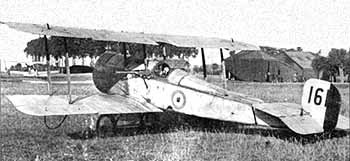|


One
of the first aircraft produced in large numbers for Britain was the
Bristol Scout. Based upon Frank Barnwell's pre-war racing plane, it was
considered fast and manoeuvrable when it entered service. The Scout was
the first attempt by the Royal Flying Corps to develop a true fighter.
Initially unarmed, Lanoe Hawker devised a method for mounting a Lewis
gun to the side of the aircraft. In March 1916, the Scout D became the
first British fighter to be armed with a synchronized machine gun. Soon
outdated by more efficient designs, it was withdrawn from service in
the summer of 1916 and used as a trainer.
With five or more victories, the highest score with this aircraft was
achieved by Charles Bell.
Country: Great Britain
Manufacturer: The British & Colonial Aeroplane Company, Ltd.
Type: Fighter
Entered Service: November 1915
Number Built: 210
Engine(s): Le Rhône, air cooled 9 cylinder rotary, 80 hp
Wing Span: 24 ft 7 in [7.49 m]
Length: 20 ft 8 in [6.3 m]
Height: 8 ft 6 in [2.6 m]
Empty Weight: 760 lbs [345 kg]
Gross Weight: 1,250 lb [567 kg]
Max Speed: 100 mph [161 km/h] at sea level
Ceiling: 16,000 ft [4,877 m]
Endurance: 2 hours
Crew: 1
Armament: 1 Vickers or Lewis machine gun |
